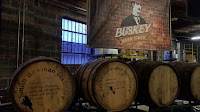Although CiderCon 2022 was a conference devoted primarily to cider professionals and members of the American Cider Association, there were plenty of seminars that benefited a layperson like me. I attended four of these seminars that were at times very complimentary. In the future, the organizers may want to schedule the seminars on a goal-based path so that each builds upon previous sessions.

 400 Years of American Alcohol: Cider, History, Cocktails and More
400 Years of American Alcohol: Cider, History, Cocktails and MoreThis session was hosted by mixologist Tiffanie Barriere and over two cocktails using Potter's Craft Cider, she highlighted the history of cider - particularly through the eyes of Black historical figures. These figures included James Madison Ruffin -- an emancipated slave who managed many agricultural projects before and after the Civil War, including the planting and maintenance of Appomattox Plantation’s apple orchards and its cider fruit. She told the story of Antoine Amedee Peychaud, who "came to New Orleans from the island of San Domingo, the former French colony that is now Haiti. By 1832 he owned an apothecary in the French Quarter where he made his famous bitters ... which was the essential ingredient in the official Sazerac cocktail. Among many bartender guides, Barriere introduced us to Tom Bullock, the famed bartender at the St. Louis Country Club and author of the 1917 bestseller The Ideal Bartender. According to George Herbert Walker, a club member and both the grandfather and great-grandfather of a chief executive, "I doubt if he has erred in even one of his concoctions."
Introductory Palate Training
This session was hosted by Darlene Hayes who also oversees the American Cider Association's Certified Cider Professional program. This was a foundational seminar on participants can familiarize themselves and train their palates to individual structural elements within cider. We sampled a control cider in terms of that cider with different levels of sugar, acids, and tannins. Worth repeating often.
A Cider Among the Faults
Nicole Leibon hosted this session on determining which cider was the innocent control cider and which were fatally flawed. The panelists discussed several faults such as Volatile Acidity from Acetic acid (vinegar) and emphasis on Ethyl acetate (nail polish), Diacetyl (overly buttered), and Acetaldehyde (stale bread).
Top of the Mitten: High Latitude Ciders from Northern Michigan
Another session hosted by Nicole Leibon and where we finally started tasting retail ciders by exploring Michigan's 45th parallel. Through two ciders each from Tandem Ciders, Left Foot Charley, and Presque Isle Farm. The beauty of this session is that these producers source the same apple varieties from the same orchards and use different fermenting methods to produce completely different ciders. Some are produced using controlled fermentation whereas others by wild ferments with some creamy and round and others funky and chewy.
Wild, Clean & Free: Harnessing the Beauty of Wild-Fermenting, Without the Flaws
This session hosted by Christine Walter of Bauman's Cider would build upon the previous by continuing the tasting of wild-fermented sparkling cider and Pet-nats. We started with the delicious Kossah Wild Fermented from Raw Cider, followed by the 2017 Roxbury Russet Pet-nat from Artifact Cider, and finishing with the Sponti 2020 from Sundstrom Cider. This last is fantastic, a wild fermented cider, aged on lees, and bottled unfiltered. Sparkling apple funk.













